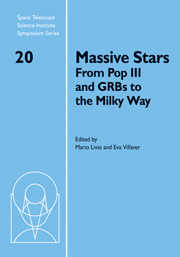Book contents
- Frontmatter
- Contents
- Participants
- Preface
- High-mass star formation by gravitational collapse of massive cores
- Observations of massive-star formation
- Massive-star formation in the Galactic center
- An x-ray tour of massive-star-forming regions with Chandra
- Massive stars: Feedback effects in the local universe
- The initial mass function in clusters
- Massive stars and star clusters in the Antennae galaxies
- On the binarity of Eta Carinae
- Parameters and winds of hot massive stars
- Unraveling the Galaxy to find the first stars
- Optically observable zero-age main-sequence O stars
- Metallicity-dependent Wolf-Rayet winds
- Eruptive mass loss in very massive stars and Population III stars
- From progenitor to afterlife
- Pair-production supernovae: Theory and observation
- Cosmic infrared background and Population III: An overview
Parameters and winds of hot massive stars
Published online by Cambridge University Press: 04 August 2010
- Frontmatter
- Contents
- Participants
- Preface
- High-mass star formation by gravitational collapse of massive cores
- Observations of massive-star formation
- Massive-star formation in the Galactic center
- An x-ray tour of massive-star-forming regions with Chandra
- Massive stars: Feedback effects in the local universe
- The initial mass function in clusters
- Massive stars and star clusters in the Antennae galaxies
- On the binarity of Eta Carinae
- Parameters and winds of hot massive stars
- Unraveling the Galaxy to find the first stars
- Optically observable zero-age main-sequence O stars
- Metallicity-dependent Wolf-Rayet winds
- Eruptive mass loss in very massive stars and Population III stars
- From progenitor to afterlife
- Pair-production supernovae: Theory and observation
- Cosmic infrared background and Population III: An overview
Summary
In recent years a new generation of model atmosphere codes, which include the effects of metal line blanketing of millions of spectral lines in NLTE, has been used to re-determine the properties of massive stars through quantitative spectral analysis methods applied to optical, IR and UV spectra. This has resulted in a significant change of the effective temperature scale of early-type stars and a revision of mass-loss rates. Observed mass-loss rates and effective temperatures depend strongly on metallicity, both in agreement with theoretical predictions. The new model atmospheres, in conjunction with the new generation of 10-m-class telescopes equipped with efficient multi-object spectrographs, have made it possible to study blue supergiants in galaxies far beyond the Local Group in spectroscopic detail to determine accurate chemical composition, extinction and distances. A new distance determination method, the flux-weighted gravity–luminosity relationship, is discussed as a very promising complement to existing stellar distance indicators.
Observationally, there are still fundamental uncertainties in the determination of stellar mass-loss rates, which are caused by evidence that the winds are inhomogeneous and clumped. This may lead to major revisions of the observed rates of mass loss.
Introduction
Hot massive stars are cosmic engines of fundamental importance, not only in the local, but also in the early universe. A first generation of very massive stars has very likely influenced the formation and evolution of the first building blocks of galaxies.
- Type
- Chapter
- Information
- Massive StarsFrom Pop III and GRBs to the Milky Way, pp. 126 - 151Publisher: Cambridge University PressPrint publication year: 2009
- 1
- Cited by



